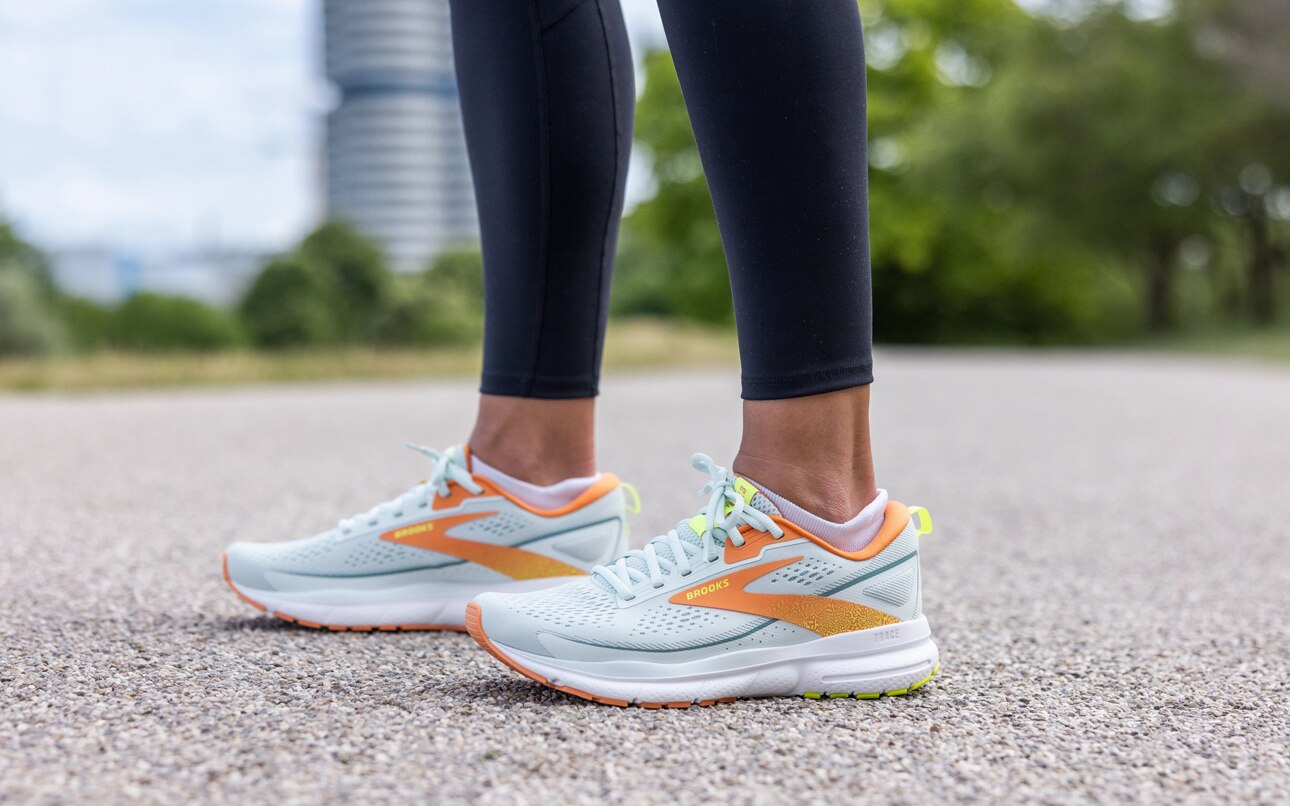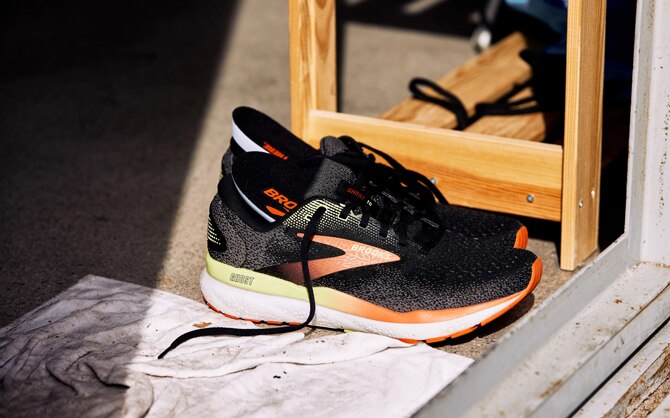What are the best Brooks shoes for plantar fasciitis?

Plantar fasciitis is annoying at best and debilitating at worst – and, as a runner, it can have a big impact on your training regime. But what exactly causes this frustrating condition? Is there anything you can do to make it go away? And what are the best shoes for plantar fasciitis? Let’s dig into all the details you need to know.
What is plantar fasciitis?
First things first, what exactly is plantar fasciitis? It’s a common condition that causes heel pain and pain around the arch of your foot and is characterised by inflammation of the plantar fascia. That’s the thick band of tissue that runs along the bottom of your foot, connecting your heel bone to your toes. It’s stretchy like a rubber band, and acts as a shock absorber. That means it supports the arch of the foot and helping with the mechanics of the foot when walking or running.
When the plantar fascia is overstretched or overused, it can cause plantar fasciitis, causing inflammation – which can make it painful to put weight on your foot and can also cause pain on your heel, like when you’re walking or running.
Symptoms of plantar fasciitis
For most people, the telltale sign of plantar fasciitis is a sharp, stabbing pain at the bottom of their heel. It can feel worst first thing in the morning when you get out of bed and may result in you hobbling for your fist few steps of the day.
You might also experience a similar sensation after you’ve been sitting down for a long time. That’s because your plantar fascia shortens overnight, or when you sit down for a long time, and then is suddenly stretched again when you start to walk.
You might also feel pain during the first few minutes of your run. However, most runners find that once your feet are warmed up, the pain fades – only to come back again at the end of your run.
Many people with plantar fasciitis also experience pain along the arch of the foot, where the thick band of plantar facia extends from your heel to your toes.
What causes plantar fasciitis?
There’s not one single cause of plantar fasciitis, so any two people with the condition may have different contributing factors. Some of the things that can cause it include:
- Ramping up your activity levels and running too many miles too soon
- Running with tight calves
- High arches – people with high arches often develop plantar fasciitis
- Wearing shoes with poor cushioning or improper support
- Lots of running or walking on hard surfaces
There are lots of conditions that can cause heel pain so if you suspect you have plantar fasciitis, it’s important to speak to a doctor or physiotherapist to understand what factors may be contributing to the condition, and to get a treatment plan.
How to treat plantar fasciitis
The treatment of plantar fasciitis usually involves lifestyle adjustments and self-care measures – and for many people, that’s enough of a cure for plantar fasciitis. However, some people will need medical intervention. It all depends on the severity of your symptoms and the impact they’re having on your life.
So, if you want to find out how to get rid of plantar fasciitis, here are some of the most common treatment options for the condition:
Rest
If running has caused the problem, and is exacerbating the pain, it’s best to take a break from running. We know – it’s not the answer you want to hear. But pushing through the pain will only make plantar fasciitis worse, not better. So, taking a break from running will help to reduce the pain, and in some instances may be enough to allow you to continue running again, pain-free. Stick to activities that don’t cause you any pain, like cycling, swimming, or upper body work in the gym.

Ice
Ice can help to reduce inflammation and ease the pain of plantar fasciitis. Apply ice to the affected area for about 15-20 minutes every 2-3 hours, especially during the first 48 hours of developing pain in your heel or arch. Many people like to freeze a water bottle, and then roll it under their foot to provide relief along the entire plantar fascia.
Stretch
Many people with tight calves or Achilles tendons develop plantar fasciitis – but stretching can help to improve your flexibility and alleviate tension in these areas. One of the best stretches to do first thing in the morning is this:
- Take your toes of one foot in one hand, and gently bend them back towards your shin
- With the other hand, gently massage the base of your heel and along your plantar fascia Hold for 15-30 seconds
- Repeat three times on both sides

Night splints and orthotics
Some people find night splints helpful. They can be worn while sleeping to keep the foot in a dorsiflexed position, helping to stretch the plantar fascia. During the day, some people use orthotics in their shoes for extra arch support.
Supportive shoes
Proper arch support is key when you have plantar fasciitis. That means waving goodbye to high heels and flip flops, and opting instead for shoes that support your heels and arches.
Shockwave therapy
In some more severe cases, your doctor or physiotherapist may recommend extracorporeal shockwave therapy (ESWT). Your physio will use a machine to generate high-energy shockwaves, delivered to your heel or bottom of your foot. They create micro-traumas in the targeted tissues, which can stimulate a healing response in your body. That means it can stimulate blood flow, reduce inflammation, and reduce your symptoms of plantar fasciitis over time.
Steroid injections
If you have particularly severe symptoms, or your plantar fasciitis doesn’t get any better after a couple of months of treatment, your doctor may prescribe steroid injections in your foot. They can offer pain relief and reduce inflammation.
What not to do with plantar fasciitis
To ensure your symptoms don’t get any worse, there are a few things you should avoid when you have plantar fasciitis. These include:
- Ignoring your symptoms: This can lead to further damage and delay the healing process.
- Excessive running: Repetitive impact, especially on hard surfaces, can make the condition worse.
- Walking barefoot on hard surfaces: You should wear supportive footwear, even when at home.
- Wearing inappropriate shoes: Shoes with inadequate arch support, worn-out soles, or insufficient cushioning can aggravate plantar fasciitis.
- Skipping your warm-up: If you are doing short runs, or other types of exercise, always remembering to warm up, especially your calf and ankle muscles.
What are the best shoes for plantar fasciitis?
We find that the best plantar fasciitis shoes have a higher drop from the heel to toe and good cushioning to take the impact away. Sometimes, a more rigid, less flexible shoe will help.
It’s a good idea to first find out whether you experience any calcaneal deviation as you walk or run. This is when your ankles roll inwards towards each other, and onto your arches, which can put a lot of pressure on the inside edge of your feet.
If you do this, then you might want to opt for a support shoe. However, if your run feels stable, or if your ankles roll outwards a little, then neutral shoes may be a better option for you. You can find out whether you experience calcaneal deviation by visiting a local running shop to have your gait analyzed.
If you need support directly under your arch, we recommend an insole. Our shoes come with a replaceable sock liner, which you can take out and insert your own insole.
Brooks plantar fasciitis shoes
So, which Brooks models should you opt for?
Support shoes
If you need a support shoe, then Adrenaline GTS is a great place to start. This shoe offers the perfect combination of support and softness, with a 12mm drop from heel to toe – which helps to put more weight in your forefoot, and reduce the impact on your heel.
What’s more, the Adrenaline GTS has great cushion underfoot and supports to keep your calcaneal deviation controlled as you walk/run.

If the Adrenaline GTS doesn’t have enough cushioning for you, then the Ariel GTS or Beast GTS model might be the shoe for you. These shoes offer excellent arch support and superior cushioning. Both the Ariel GTS as the Beast GTS offer the same 12mm drop as the Adrenaline GTS, but thanks to the wide base, soft cushioning, and a generous fit, it’s great for orthotics.
Neutral shoes
If you’re looking for a neutral shoe, then the Ghost is a good place to start. It also offers a 12mm drop from heel to toe, with a slightly wider toe box to give you a little more wiggle room. It’s also packed with DNA LOFT v3 cushioning for added comfort on the run.

Alternatively, the Ghost Max might work for you. It keeps your gait neutral while offering added width for stability. It has soft cushioning, a GlideRoll Rocker and low drop to reduce energy absorption in your foot’s soft tissues, which can reduce stress on your plantar fascia.

Where are you experiencing pain?
Plantar fasciitis occurs when the band of tissue running beneath the length of the sole becomes inflamed and painful. Pain may be relieved by offloading the plantar fascia through movement restriction of the foot or by adding more cushion under the heel to alleviate pain at first touch down. The best shoe depends on how the pain is manifesting (in the heel versus under the arch). The Ghost Max restricts motion of the foot with increased bending stiffness while the Ghost has soft plush heels at touch down.
Not sure what Brooks running shoe is right for you? Try our shoe finder or try a running store to try on a pair of Brooks in person.
Our writer's advice is intended for informational or general educational purposes only. We always encourage you to speak with your physician or healthcare provider before making any adjustments to your running, nutrition, or fitness routines.
